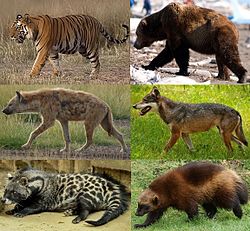Carnivora
| Carnivorans Temporal range: 42–0 Ma Middle Eocene-Holocene |
|
|---|---|
 |
|
| Various carnivorans, with feliforms (tiger, spotted hyena and African civet) to the left, and caniforms (brown bear, gray wolf and wolverine) to the right | |
| Scientific classification | |
| Kingdom: | Animalia |
| Phylum: | Chordata |
| Clade: | Synapsida |
| Class: | Mammalia |
| Infraclass: | Placentalia |
| Order: |
Carnivora Bowdich (1821) |
| Families | |
|
|
Carnivora (/kɑːrˈnɪvərə/; from Latin carō (stem carn-) "flesh" and vorāre "to devour") is a diverse order that includes over 280 species of placental mammals. Its members are formally referred to as carnivorans, whereas the word "carnivore" (often popularly applied to members of this group) can refer to any meat-eating organism. Carnivorans are the most diverse in size of any mammalian order, ranging from the least weasel (Mustela nivalis), at as little as 25 g (0.88 oz) and 11 cm (4.3 in), to the polar bear (Ursus maritimus), which can weigh up to 1,000 kg (2,200 lb), to the southern elephant seal (Mirounga leonina), whose adult males weigh up to 5,000 kg (11,000 lb) and measure up to 6.9 m (23 ft) in length.
Some carnivorans, such as cats and pinnipeds, depend entirely on meat for their nutrition. Others, such as raccoons and bears, depending on the local habitat, are more omnivorous: the giant panda is almost exclusively a herbivore, but will take fish, eggs and insects, while the polar bear subsists mainly on seals. Carnivorans have teeth and claws adapted for catching and eating other animals. Many hunt in packs and are social animals, giving them an advantage over larger prey.
...
Wikipedia
